Remains Relocation: Upon completion of a new National Cemetery outside Vientiane Capital, the government of Laos decided to move fourteen of the original leaders of the country from their current resting place to the new cemetery, despite the protests from many of the families. Nobody wanted the remains of their loved ones moved from their current resting spot to the cemetery located well outside the city. The government officials that consulted with Peep's mom assured her that they would take care of all the details. However, a day or two before the ceremony they presented the family with a laundry list of items they needed to take care of prior to the ceremonies. There were a total of five ceremonies that took place over two days, 23-24 of March, 2012.
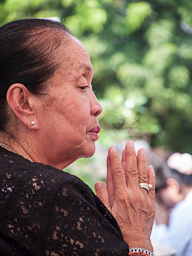
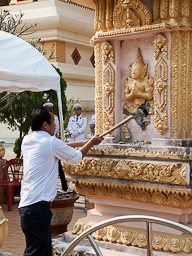
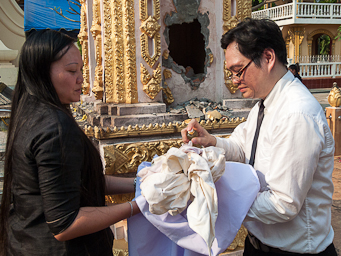
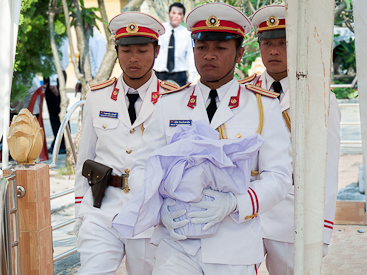
Disinterment Ceremony: The move began with the removal of dad's remains from his current stupa outside a temple located by That Luang, near the center of Vientiane. After the monk's prayers, the stupa was broken into with a sledgehammer and the cloth-wrapped bowl containing dad's remains were removed by Peep's older brother Paap. The remains consist of the bones collected by the family members following the burning of his body, and possibly some of the ashes as well (I have never been able to get a precise answer as to whether or not some ashes are included). The remainder of his ashes were released into the Mekong prior to the placement of the bones in the stupa. The remains were then taken by honor guard to the museum for the first president of the country, heading away from the city.
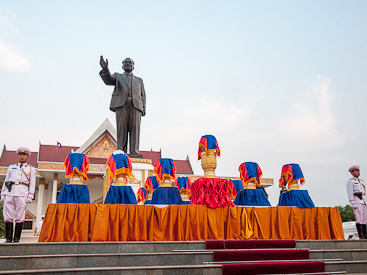
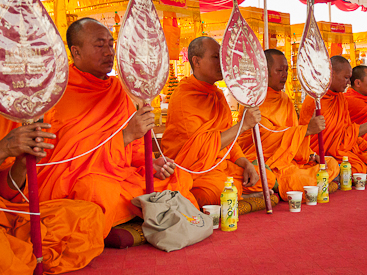
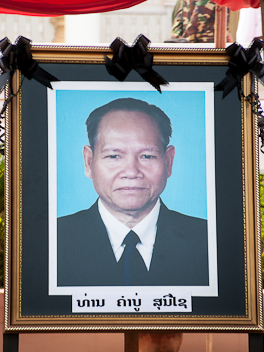
Second Ceremony: Once at the museum, the remains were placed on a table set up in the middle of the plaza in front of the museum, where they remained exposed to the elements overnight. A much longer Buddhist ceremony was then held where the 90-year-old monk lectured the leaders of the country in attendance to do good with their lives, comparing them to the dead if they don't. That was Peep's favorite part of the day. As part of their duties, the families provided large photos to be used during the procession to the cemetery the next day. However, the government was unhappy that the picture we chose for dad, the one the family liked best and used on his original stupa, because it was one of only two in b&w instead of color, so they made us get them a color photo. Peep was up to 12:30am getting them their photo (they also used a smaller version of this color photo on his new stupa).
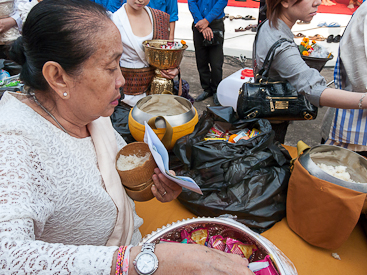
Alms Giving Ceremony: On the morning of the second day, we all returned to the museum early for a third ceremony given by the monks and for almsgiving. A different monk talked and this time told the officials to protect the environment and use Lao's natural resources wisely. After the speeches, everyone gave alms to the 120 monks at the ceremony. The alms included rice, snack cakes and money given by each participant. The monks made out well. I didn't give any alms myself, but rather held the silver bowl containing the snack cakes for mom so she didn't have to juggle it with the rice basket and money envelope. The event, as well as all the events throughout the two days, was well-covered by photographers and videographers, but their attention was mainly taken up with the government officials in attendance, rather than the families.
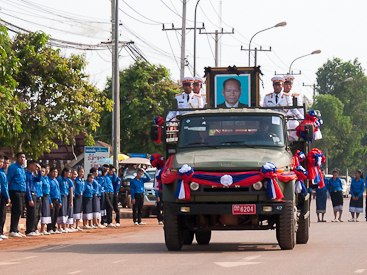
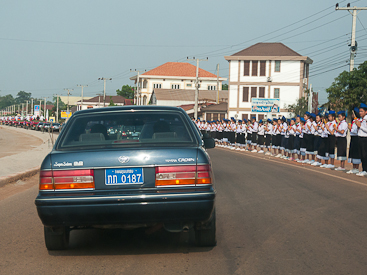
Procession Ceremony: We had to return to the museum yet again for another ceremony that afternoon. The prayer and speeches were much shorter, but it took quite a bit of time to load the remains of the former leaders onto the military trucks, each in its own. Dad was twelfth of the fourteen included in the ceremony. After all of them were loaded up, we began our long drive eleven miles outside the city to the cemetery. The military trucks with the remains went first, followed by the government officials, and then finally the families, which were allowed one car each. With only a few gaps, the road was lined with people the entire way. Each village head along the route was required to make sure people from his village attended. There were many schoolchildren lining many portions of the route. As we approached the cemetery, located outside the city where too few people live, government employees were bussed out to ensure that no large sections were missed. I am sure many of them would attend anyway, while others didn't mind the requirement that they be there.
Once we reached the cemetery, the entire procession was stopped on the road and they started unloading the remains as soon as the government officials, who were at the head of the line, were ready. Fortunately, we had arrived at the museum early in the afternoon and were able to get in line right behind the government cars, so mom, who has trouble walking, didn't have too far to go just to get to the gates of the cemetery. Even though dad was twelfth in line, we were just barely able to get there before they headed into the cemetery. Some families didn't make it and therefore couldn't accompany the remains of their loved ones as they were taken into the cemetery.
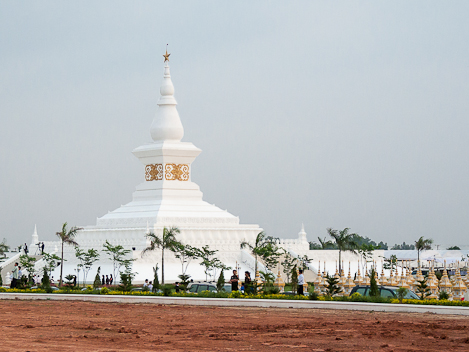
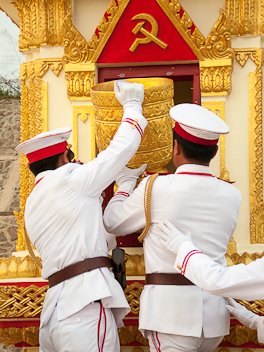
Reinterment Ceremony: Next came the ceremony at the main stupa of the cemetery, where the president of Lao gave a speech. Being twelfth, we were barely able to get a seat behind the government officials in attendance. Some non-family members took the prized seats, forcing some family members to stand outside the tents to listen to the lengthy speech. We then lined up for the procession of dad's remains from the main stupa to his stupa, located at the very back of the cemetery. After everyone was lined up, I looked back at the section in which the family members that could get a seat got one, and noticed that it was still half full. For each and every procession where the family followed behind the honor guard carrying the remains, someone unrelated and not even close to dad in life took it upon themselves to join our group. It was simply to be seen. This was the social event of the year.
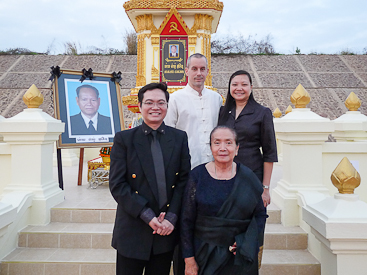
After reaching the stupa, the guards carrying the remains placed them inside the new, government-designed stupa and closed it with the new, government-designed plate (like a headstone). The only consolation with the uniformity of all the stupas is that they mimic the design of dad's original stupa, (previously) unique and designed by Paap. Then it was group picture after group picture after group picture until all the important government people left. Peep's entire family then went out to eat, but I had them drop me off at the hotel instead, falling asleep long before Peep finished the three-hour meal and returned.
Dad's old stupa will eventually be completely destroyed. It appears that they will simply expand the plaza by laying bricks down where it now stands. So, tourists visiting Vientiane and the temple next to That Luang will no longer be able to see examples of how the Lao deal with the dead or the varied types of stupas that are constructed in their honor. It is doubtful that any will make the trip outside the city to see the national cemetery. Not only the remoteness of the location, but also the fact that everyone (yes, even including mom) needs a special pass issued by the government to go into the cemetery, will keep tourists away.

